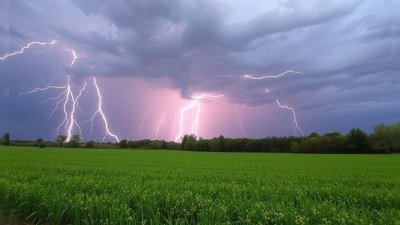Why Does It Feel Hotter Right Before a Thunderstorm
The science behind pre-storm heat, rising humidity, and sudden weather shifts

Ever stepped outside before a thunderstorm and felt like the air was extra hot and heavy? It’s not your imagination—many people notice an intense, almost suffocating heat just before a storm rolls in. This phenomenon is caused by a combination of rising humidity, air pressure changes, and shifting wind patterns. Understanding why it feels hotter before a thunderstorm can help you predict incoming weather and make sense of those sudden, dramatic shifts in temperature.
Rising Humidity Traps Heat
Before a storm, the air often becomes thick and muggy because moisture levels are rising. As warm air holds more water vapor, the humidity increases, making it harder for your body to cool itself through sweating. The result? A sticky, oppressive feeling that makes the air feel much hotter than it actually is.
Barometric Pressure and Heat Compression
One of the key factors behind pre-storm heat is barometric pressure. As a thunderstorm approaches, the atmospheric pressure begins to drop. This creates an effect known as heat compression, where the air at ground level is slightly squeezed, making it feel warmer and more stagnant. This compressed air traps heat close to the surface, adding to the sensation of increased warmth.
The Calm (and Heat) Before the Storm
Thunderstorms are caused by the clash between warm, moist air and cooler, drier air. Before a storm, warm air is lifted upward, while cooler air remains high in the atmosphere. Since there’s less wind movement at the surface, the air can feel still and stifling. Without a breeze to provide relief, the heat becomes more noticeable.
Why It Cools Down After the Storm Hits
As soon as rain begins to fall, the temperature often drops dramatically. This happens for two reasons:
- Cold downdrafts: Thunderstorms bring strong downward gusts of cooler air from higher altitudes, rapidly cooling the surface.
- Evaporative cooling: As raindrops hit the ground and evaporate, they absorb heat from the surrounding air, creating a cooling effect.
The bigger the storm, the more dramatic the temperature shift. Some areas experience a drop of 10–20°F within minutes after a thunderstorm begins.
The Electrical Charge Factor
Some scientists believe that changes in electrical charge in the atmosphere before a storm could also contribute to how we perceive heat. While this is less studied, many people report feeling a certain heaviness or tension in the air—possibly due to static electricity building up before lightning strikes.
How to Stay Comfortable in Pre-Storm Heat
Since pre-storm conditions can be particularly uncomfortable, here are some ways to stay cool:
- Drink plenty of water: The increased humidity can cause excessive sweating, leading to dehydration.
- Seek shade: Avoid direct sunlight, as humidity makes it harder for your body to release heat.
- Pay attention to storm warnings: If you notice an intense rise in heat and humidity, a thunderstorm may be on the way.
- Prepare for the temperature drop: If the storm is severe, temperatures can fall quickly, so keep an extra layer nearby.
Pre-Storm Heat is More Than Just a Feeling
That sudden, suffocating heat before a thunderstorm is a real atmospheric phenomenon caused by humidity buildup, pressure changes, and heat compression. The good news? It’s usually a sign that relief is on the way. Once the storm arrives, the temperature drops, the air clears, and the oppressive heat fades—at least until the next storm cycle begins.











